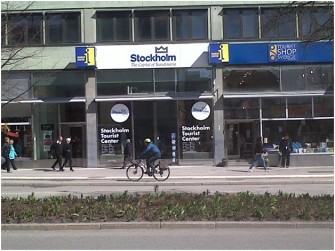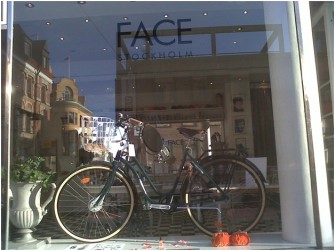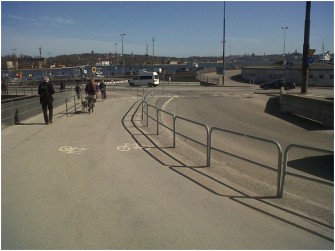
With MAMILs only you cannot build a cycling region – What Stockholm needs to do to get fit for cycling
Co-organised by ECFmember Cykelframjandet, the Stockholm Dutch Embassy hoisted last week a day seminar on ‘Building a cycling region’. ECF Policy Officer Fabian Küster spoke on cycling highways and ‘NGO – public authorities’ cooperation’ and gives us here his impression whether Stockholm is on the brink to become a cycling city.
 As I descend the Main Central Station, the tourist centre is welcoming me with a self-proclaimed logo ‘Stockholm – The Capital of Scandinavia’. Whatever this is supposed to mean, it sets the tone for an ambitious capital city in Europe’s north. And as I search my way to Söldermolm where the Dutch Embassy is located, I sense immediately the traffic is truly capital-like old-style: big roads and junctions, enormous bridges crossing the waters, this is a city that has been made fit for motorized traffic in the past. In particular the crossing from the old town district Gamla Stan to neighboring Söldermolm is an unpleasant experience: a noisy, messy, wide concrete bridge – admittedly with some Copenhagen-style cycle paths, but I can’t imagine that it is fun to cycle here.
As I descend the Main Central Station, the tourist centre is welcoming me with a self-proclaimed logo ‘Stockholm – The Capital of Scandinavia’. Whatever this is supposed to mean, it sets the tone for an ambitious capital city in Europe’s north. And as I search my way to Söldermolm where the Dutch Embassy is located, I sense immediately the traffic is truly capital-like old-style: big roads and junctions, enormous bridges crossing the waters, this is a city that has been made fit for motorized traffic in the past. In particular the crossing from the old town district Gamla Stan to neighboring Söldermolm is an unpleasant experience: a noisy, messy, wide concrete bridge – admittedly with some Copenhagen-style cycle paths, but I can’t imagine that it is fun to cycle here.
Entering Söldermolm is much better. A good mix of residential, offices, shops. Quite a few shops actually display bicycles in their windows – signs of clever marketing or an underlying vivid cycling culture?
 I’ll find out at the day-seminar at the Dutch Embassy. The seminar was a joint project by ECF member Cykelfrämjandet, the Dutch Cycling Embassy, the Swedish Transport Administration Trafikverket, the Swedish research program CyCity and us, the European Cyclists' Federation. About 100 people attend the seminar, thereof many local politicians and officials from the Greater Stockholm Region, but also other Swedish cities such as Gothenborg, Malmö and Linköping. Local context, national importance.
I’ll find out at the day-seminar at the Dutch Embassy. The seminar was a joint project by ECF member Cykelfrämjandet, the Dutch Cycling Embassy, the Swedish Transport Administration Trafikverket, the Swedish research program CyCity and us, the European Cyclists' Federation. About 100 people attend the seminar, thereof many local politicians and officials from the Greater Stockholm Region, but also other Swedish cities such as Gothenborg, Malmö and Linköping. Local context, national importance.
As most other European cities, cycling declined rapidly after World War II as people aspired to cars and city planners accomodated the cities to motorised traffic. However, since the early 2000s, cycling is climbing again, with a 80 % increase in 10 years’ time. This is comparable to what other European capital cities have witnessed, including London and Dublin. To further increase cycling, a Regional Cycling Plan is in the make, with the ambition to increase cycling to 20 % by 2030. To achieve this aim, the Capital region will need to see a serious upgrade in its cycling infrastructure. 3 workshops therefore focused on ‘cycle highways’, with the notion that these cycle fast lanes will need to be fully embedded in a dense network of local cycle routes. Cycle highways are only a success if they are properly fed!
Building high-quality bicycle route networks is one thing, make people using it another. Other seminar workshops therefore focused on marketing cycling, the use of ITS and the relationship between NGOs and public authorities. Representatives from local authorities acknowledged that they need input from cycle users to make a good cycling policy, but criticised that Cykelfrämjandet, the Swedish cyclists’ union, is a somewhat old-fashioned organisation recruiting from mainly so-called MAMILs (Middle Aged Men in Lyrca) who love cycle touring. Cykelfrämjandet could therefore not speak on behalf of all parts of society. However, it therefore recently developed a brand new app for reporting cycling obstacles – cykelrAPPorten – in an attempt to change its public image and to reach out to young users. The release of the app is expected in May. The Dutch seminar presenters also repeatedly pointed out to the importance of role models, and the significance of the Dutch royal family publicly using their bikes. The Swedish royals have yet to be seen on bicycles.
Regarding daily cycling, Stockholm can neither compete with its Scandinavian sister city Copenhagen nor with Amsterdam or any other city from the Netherlands. If the self-proclaimed title ‘The Capital of Scandinavia’ also should hold some truth on daily cycling – and by extension quality of life – it needs to fully implement its Regional Cycling Plan, and possibly do a lot more. A Swedish extension to the Dutch-Danish friendly cycle competition – I’d like that!
Notes/ links:
- The seminar was co-financed by ECF’s leadership program.
- Seminar presentations: http://sweden.nlembassy.org/news/2013/04/building-a-cycling-region.html
- Seminar pictures: https://www.facebook.com/DutchEmbassySweden/photos_stream
 About the Author
About the Author
Fabian Küster is a Senior Policy Officer at the European Cyclists’ Federation. He has previously worked in Brussels for a German Member of European Parliament and the German Embassy. He has wealth of experience in and around the EU institutions, and is an expert in the EU policy field of bicycles
- Log in to post comments
Contact the author
Recent news!
Upcoming events
Contact Us
Avenue des Arts, 7-8
Postal address: Rue de la Charité, 22
1210 Brussels, Belgium











